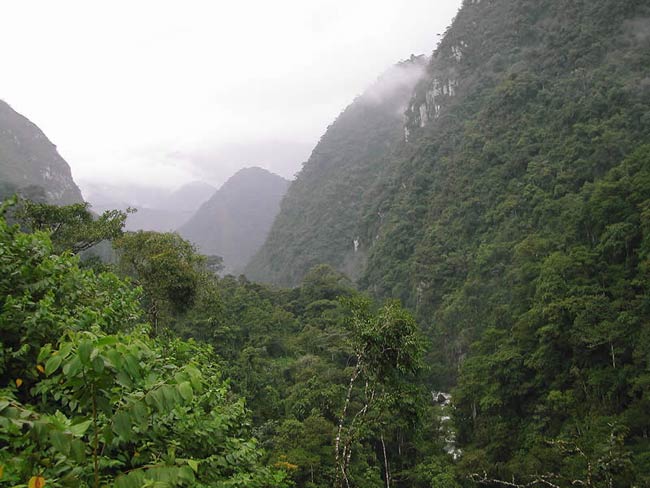Life Beyond Earth's Tropic Zones

Living in the tropics — hands down — beats living at the poles. At least that's the consensus of the high number of species crowding near the equator.
However, the underlying reason behind this preference for low latitude real estate has eluded biologists. A recent study suggests that most species originate in the tropics. The results may lead to a better understanding of what a planet may need for life to thrive and survive.
The latitudinal diversity gradient (LDG) is a ubiquitous feature of life on Earth. The number of animal and plant species peaks near the equator and drops off toward the poles. Fossil evidence shows this trend goes back millions of years.
"The gradient is pretty dramatic for almost everything," says Andrew Krug of the University of Chicago.
To understand where the LDG comes from, Krug and his colleagues (David Jablonski, James Valentine and Kaustuv Roy) have looked at the fossils of bivalves — the class of animals that includes clams, scallops, oysters and mussels. The researchers found that new genera (the category right above species) arose more often in the tropics and from there spread to higher latitudes. Their paper appears in an upcoming issue of Astrobiology Journal.
Making the gradient
The LDG was first documented 200 years ago, and several explanations for this phenomenon have been put forth. There are those who say it's due to warmer temperatures, more sunlight, or larger ranges in the lower latitudes.
"We've still not converged on a solution," Krug says.
Breaking space news, the latest updates on rocket launches, skywatching events and more!
Biologists are keen to have a clear understanding of the LDG because it may explain how life evolved to populate seemingly every niche of the planet. It could also uncover the role that climate and geology play in maintaining Earth's biodiversity.
"Clams, birds, fish, ants — they all show this diversity pattern," Krug says. "It implies that there is a fundamental property of life driving this distribution of species."
Cradle or Museum?
Many biologists try to relate the LDG to regional differences in climate and geography, but Krug and his colleagues think the focus should be on how evolution varies with latitude.
"You can't ignore history," Krug says.
The tropics could be a "cradle," giving birth to more species than the higher latitude temperate and polar zones. Or it could be a "museum," collecting lots of old species because the extinction rate is relatively low.
"Either of these will provide higher levels of species in the tropics," Krug says.
To explore these possibilities, the researchers concentrated on bivalves. These two-shelled marine organisms clearly follow the LDG pattern, with over 2000 species in the tropics but only around 50 at the poles. They are good to study because they can be found across the oceans with a wide range of habitats and feeding strategies. They are also well-represented in the fossil record over the last 11 million years.
The researchers analyzed the bivalve fossil record to find where different genera appeared first. The data showed that the "point of origin" was in the tropics 75 percent of the time.
The implication is that species originate predominantly in the tropics. There's also apparently a lower extinction rate near the equator, which means the tropics act as both cradle and museum.
In order to explain the biodiversity seen at higher latitudes, the scientists speculate that tropical lineages migrate into the temperate and polar zones when the opportunity arises. A large fraction, therefore, of all lineages came out of the tropics.
"The tropics are the engine of diversity both at low latitudes and high," Krug says.
Garden of Eden
"The stability of solar energy may ultimately be the basis for the preferential origin and accumulation of diversity in the tropics," Jablonski said, but the researchers have not yet verified this hypothesis.
Whatever the underlying factors may be, Krug says that biologists may get some insights by combining the spatial pattern of evolution with temporal fluctuations in biodiversity.
For example, there may have been an expansion of tropical regions during epochs of increased speciation (such as the recovery following the end Cretaceous mass extinction). Or perhaps the migration of some species out of the tropics helped life survive global scale catastrophes.
"It may tell us how we went from the origins of life to the vast biodiversity that we have today," Krug says.
What about on other planets? Krug says it's too soon to say, but it may turn out that biology depends on a diversity gradient of some kind. We might discover, for example, that life is unlikely to survive the occasional asteroid or climate swing unless there is an engine of biodiversity somewhere on the planet.
However, this engine may not be in the same place on another planet.
"You can have too much of a good thing,? Jablonski says. If the sunlight is too strong or the temperatures are too high, "the position of the diversity maximum on other inhabited planets may not be equatorial."

Michael Schirber is a freelance writer based in Lyons, France who began writing for Space.com and Live Science in 2004 . He's covered a wide range of topics for Space.com and Live Science, from the origin of life to the physics of NASCAR driving. He also authored a long series of articles about environmental technology. Michael earned a Ph.D. in astrophysics from Ohio State University while studying quasars and the ultraviolet background. Over the years, Michael has also written for Science, Physics World, and New Scientist, most recently as a corresponding editor for Physics.
